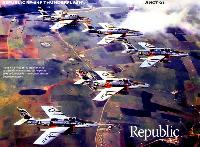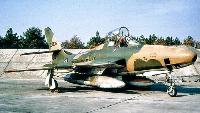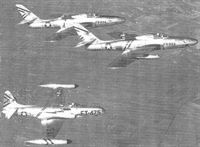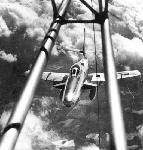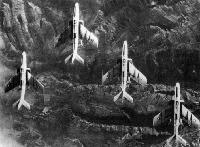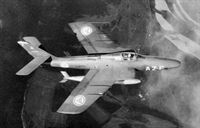
Варианты
- Republic - F-84 Thunderjet - 1946 - США
- Republic - F-91 Thunderceptor - 1949 - США
- Republic - F-84F Thunderstreak - 1950 - США
- Republic - RF-84F Thunderflash - 1952 - США
- Republic - XF-84H - 1955 - США
Republic F-84 Thunderjet
<...>
Последним вариантом базовой модели стал разведывательный RF-84F Thunderflash с ТРД J65-W-7 тягой 34,69 кН, воздухозаборниками в корневой части крыла и фотокамерами в носовой части фюзеляжа. Было построено 715 самолетов, из них 386 поступило в авиацию стран НАТО.
Для расширения разведывательных возможностей 25 F-84F были переделаны по программе ВВС США FICON (fighter conveyor) для подвески на трапеции под самолетом GRB-36F - вариантом гигантского бомбардировщика Convair B-36. После взлета разведчики GRF-84F (позднее обозначение сменили на RF-84K) подцеплялись к носителю, доставлявшему их в необходимый район. После отцепки и выполнения задания RF-84K мог снова подцепиться к транспорту-носителю для возвращения на базу. Самолеты F-84F и RF-84F были последними в семействе, остававшимися на вооружении ВВС США, и многие из них были переданы в авиацию Национальной гвардии, а в 1971 году полностью сняты с вооружения.
- Описание
Фотографии
-
Air Enthusiast 1998-11 / D.Gordon - European 'Flashes
Регистрационный номер: FS-911 [2] RF-84F-10-RE Thunderflash 51-1911 of the 38th TRS, 10th TRW, 1955.
-
Air Enthusiast 1998-11 / D.Gordon - European 'Flashes
Регистрационный номер: FS-313 [3] RF-84F-25-RE Thunderflash 52-7313 of the 303rd TRS, 1956.
-
Air Enthusiast 1998-11 / D.Gordon - European 'Flashes
Регистрационный номер: FS-347 [2] RF-84F-25-RE Thunderflash 52-7347 of the 302nd TRS, 1957.
-
Aviation Historian 35 / K.Lande - Flash!
Republic RF-84F-36-RE serial 52-8747, coded T3-L, was one of a batch of 50 built at the company’s factory at Farmingdale, New York, and is seen here in its original RNoAF bare-metal scheme. On the fuselage below the windscreen is a cartoon motif of Donald Duck on a magic carpet with a camera in his hands, denoting the unit’s photo-recce role.
-
Мировая Авиация 217
RF-84F Thunderflash из 717-й эскадрильи норвежских ВВС. Норвегия получила 35 самолетов RF-84F, которые состояли на вооружении в 1956-1969 годах. Этот "AZ-B" в 1970 году вернули США, он был уничтожен во время испытаний вооружения.
-
Aviation Historian 35 / K.Lande - Flash!
RF-84E-26-RE serial 51-17053, coded AZ-G, in the type’s final colour scheme in RNoAF service, comprising camouflage upper surfaces, white codes and Aluminium-painted undersides. This aircraft is currently on display at the Norwegian Armed Forces Aircraft Collection at Gardermoen, north of Oslo.
-
Мировая Авиация 217
Тайваньские ВВС получили первые самолеты F-84G незадолго до начала корейской войны (1953 год). На Тайвань самолеты, переданные с баз хранения дальневосточной группировки ВВС США (Far East Air Force - FEAF), перегонялись американскими летчиками. Следом Тайвань получил и RF-84F. С февраля 1956-го по февраль 1964 года 12-я тактическая разведывательная эскадрилья 5-го истребительного авиакрыла эксплуатировала 25 самолетов RF-84F.
-
Мировая Авиация 221
Помимо стран НАТО, которым досталось большинство тактических разведчиков RF-84F Thunderflash, эти самолеты получали и другие союзники США, включая Тайвань. Этот самолет нес службу в 1955-1965 годах.
-
Air Enthusiast 2007-07 / D.Gordon - Last of the Best /Post-war combat/ (1)
Регистрационный номер: FS-003 An RF-84F on the ramp at Pisa Air, Italy, in July 1956. This was the only RF-84F in the 38th TRS equipped with two 230-gallon external fuel tanks.
-
Air Enthusiast 2001-09 / D.Gordon - TAC Recon Masters (2)
Регистрационный номер: FS-007 Captain Jack Coghlan flying RF-84F 51-17007 over Germany in 1956. Jack Coghlan was the Ops Officer for the 303rd TRS.
-
Air Enthusiast 2007-07 / D.Gordon - Last of the Best /Post-war combat/ (1)
Регистрационный номер: FS-011 38th TRS, the last of the best
-
Air Enthusiast 1998-11 / D.Gordon - European 'Flashes
Регистрационный номер: FS-292 Rare colour photo of RF-84F-25-RE 52-7292 of the 32nd TRW, 66th TRS, at Phalsbourg, 1957.
-
Air Enthusiast 2007-07 / D.Gordon - Last of the Best /Post-war combat/ (1)
Регистрационный номер: FS-364 An RF-84F on a flight from Aviano, Italy, to Wheelus AFB, Tripoli, Libya, September 1956.
-
Air Enthusiast 2007-07 / D.Gordon - Last of the Best /Post-war combat/ (1)
Регистрационный номер: FS-368 Two 38th TRS RF-84FS on take-off roll at Hahn.
-
Мировая Авиация 217
Регистрационный номер: FS-373 [2], FS-381 [2] Пять RF-84F из 66-го тактического разведывательного авиакрыла, 1956 год. Впереди - самолет командира авиакрыла.
-
Air Enthusiast 2001-09 / D.Gordon - TAC Recon Masters (2)
Регистрационный номер: FS-862 [2] The colourful 51-1862 in flight
-
Air Enthusiast 2001-09 / D.Gordon - TAC Recon Masters (2)
Регистрационный номер: FS-862 [2] RF-84F 51-1862 being checked out at Sembach. No '862 was the second to be received by the 302nd. It carries the colours of the four squadrons of the 66th TRW in a band around the fuselage.
-
Air Enthusiast 2001-09 / D.Gordon - TAC Recon Masters (2)
Регистрационный номер: FS-381 [2] Loading up RF-84F 52-7381 of the 302 TRS, 1957.
-
Air Enthusiast 2007-07 / D.Gordon - Last of the Best /Post-war combat/ (1)
In July, 1956 the 38th TRS took part in a 'simulated forward air operation' at Hahn. Here is Dick Cathriner sitting in the aircraft assigned to 1st Lt Grayson Powell.
-
Air International 1990-11 / L.Peacock - B-36: Convair's "Big Stick" /Warbirds/ (2)
Во время проводившихся учений для придания большего реализма самолеты Peacemaker часто перехватывались истребителями из стратегических авиационных крыльев. В задачу этих подразделений входило сопровождение и защита флота бомбардировщиков.
The Project "Tom-Tom" RB-36F (serial 49-2707) accompanied by one of the two RF-84Fs (51-1848/1849) that were modified to permit wingtip to wing-tip hook-ups.Другие самолёты на фотографии: Convair B-36 Peacemaker - США - 1946
-
Air International 1989-01 / Talkback
The Republic RF-84F photographed by Jan van den Over upon its return to Volkel
-
Air Enthusiast 1992-12 / R.Shaw - Greek Guardians
Larissa employs three recently-retired RF-84F Thunderflashes in the decoy role.
-
Мировая Авиация 217
Греция - последний оператор RF-84F, окончательно самолет был списан только в 1991 году. 348-я эскадрилья, летавшая на RF-84F с августа 1956 года, стала последним эксплуатантом.
-
Мировая Авиация 224
Самолеты Thunderstreak и RF-84F Thunderflash в больших количествах состояли на вооружении ВВС стран НАТО. Греция сняла такие самолеты с вооружения одной из последних.
-
Мировая Авиация 217
Регистрационный номер: EB-344 Данный RF-84F, "EB-344", принадлежал Люфтваффе - крупнейшему оператору данных самолетов в Европе. Сегодня эта машина находится в музее Люфтваффе (Берлин - Гатоу).
-
Авиация и Космонавтика 2014-09 / Д.Пичугин - Ягель принимает гостей: "Тайгер Мит-2014" /Военные учения/
Регистрационный номер: EB-250 -
Aeroplane Monthly 1999-06 / M.Oakey, T.Harmsworth - News
Republic RF-84F Thunderflash 51-17053 AZ-G is moved across the road outside the former German World War Two hangar at Gardermoen to commence its journey to its new home during September 1998.
-
Aviation Historian 35 / K.Lande - Flash!
Thunderflash serial 52-7319, coded AZ-C, was originally operated by France’s Armee de I’Air, and was acquired by the RNoAF in October 1963. It served with No 717 Sqn until November 1969, when it was withdrawn from service. Four former RNoAF examples survive today as museum exhibits in Norway, plus one nose section.
-
Aviation Historian 35 / K.Lande - Flash!
Two generations of photo-reconnaissance specialists together in January 1969 - nearest the camera is RF-84F serial 52-8714, coded AZ-F, beside Northrop RF-5A serial 68-9105, AZ-M. The much more capable twin-engined RF-5A took over the RF-84F’s role completely when the last RNoAF Thunderflash was retired in June 1970.
Другие самолёты на фотографии: Northrop F-5A Freedom Fighter - США - 1963
-
Aviation Historian 35 / K.Lande - Flash!
A pair of Luftforsvaret (Royal Norwegian Air Force - RNoAF) RF-84Fs await their next photographic reconnaissance sortie in the mid-1960s.
-
Aviation Historian 35 / K.Lande - Flash!
A line-up of Thunderflashes in the early 1960s, after No 717 Sqn’s adoption of “AZ” codes. The RNoAF constitued an important part of Nato’s ability to monitor its northern flank, Norway and the Soviet Union sharing a 196km (122-mile) border between Norway’s Sor-Varanger municipality and the USSR’s Murmansk Oblast.
-
Aviation Historian 35 / K.Lande - Flash!
Kaptein Knut Lande, a self-portrait of whom is seen in “the office”, started his flying career in 1964 and went on to serve as a photo-reconnaissance fighter pilot, flying instructor and test pilot during his career with the RNoAF.
-
Aviation Historian 35 / K.Lande - Flash!
The author poses for a photograph beside a Thunderflash after a flight. He has been an active civil aerobatic pilot and flying instructor since 1970, and has written textbooks and training programmes for aerobatic pilots and instructors, as well as published numerous articles in aviation periodicals.
-
Air Enthusiast 1998-11 / D.Gordon - European 'Flashes
Регистрационный номер: FS-005 RF-84F-25-RE 51-17005 of the 32nd TRS, 10th TRW, showing off its potential camera fitments at Spangdahlem, 1956.
-
Air Enthusiast 2001-09 / D.Gordon - TAC Recon Masters (2)
Регистрационный номер: FS-038, FS-356 Line Inspection, 303rd TRS, 1957. Note that the colour scheme changed for the squadrons of the 66th in early 1957.
-
Авиация и Космонавтика 2013-06 / К.Кузнецов, Г.Дьяконов - Главный калибр (4)
Регистрационный номер: FS-258 Обозначение самолета RF-84F/RBF-84F, участвующего в программе FICON, было заменено на RF-84K в начале 1956 г. Под крылом самолёта бомба Mk-7. Отогнутые вниз плоскости стабилизатора говорят о том, что RF-84K предназначен для подвески под бомбардировщик GRB-36D.
-
Air Enthusiast 1998-11 / D.Gordon - European 'Flashes
Регистрационный номер: FS-294 RF-84F-25-RE 52-7294 of the 66th TRW at Sembach, 1956. Note the lack of unit insignia and the exercise markings below the cockpit and on the fin.
-
Air Enthusiast 2001-09 / D.Gordon - TAC Recon Masters (2)
Регистрационный номер: FS-312 RF-84F 52-7312 of the 303rd TRS over Germany, 1956.
-
Air Enthusiast 1998-11 / D.Gordon - European 'Flashes
Регистрационный номер: FS-313 [3] Colourful markings of the 303rd TRS, on RF-84F-25-RE 52-7313, 1957.
-
Air Enthusiast 2007-07 / D.Gordon - Last of the Best /Post-war combat/ (1)
Регистрационный номер: FS-313 [3] RF-84F 52-7313 is flying over the Atlas mountains. The single green fuselage band outlined in white, mark this as a flight commander's aircraft.
-
Air Enthusiast 2007-07 / D.Gordon - Last of the Best /Post-war combat/ (1)
Регистрационный номер: FS-342 Flying over the Bavarian Alps in 1956 a 38th TRS RF-84F in the company of a 32nd TRS example.
-
Air Enthusiast 1998-11 / D.Gordon - European 'Flashes
Регистрационный номер: FS-343 Another 'Dash 25' Thunderflash, 52-7343 of the 303rd TRS, 66th TRW, at the Wethersfield 'Open House', 1957.
-
Air Enthusiast 1998-11 / D.Gordon - European 'Flashes
Регистрационный номер: FS-347 [2] Air-to-air of RF-84F-25-RE 52-7347 of the 302nd TRS, 66th TRW, 1956.
-
Air Enthusiast 2001-09 / D.Gordon - TAC Recon Masters (2)
Регистрационный номер: FS-373 [2] Quartet of RF-84F of the 330rd TRS, 1955.
-
Air Enthusiast 2001-09 / D.Gordon - TAC Recon Masters (2)
Регистрационный номер: FS-377 Hangar maintenance on RF-84F 52-7377, Sembach, 1957.
-
Air Enthusiast 2007-07 / D.Gordon - Last of the Best /Post-war combat/ (1)
In autumn 1956 the 10th TRW received its first RF-84s destined for the 32nd and 38th TRS.
-
Авиация и Космонавтика 2005-07 / М.Никольский - Истребитель-бомбардировщик Рипаблик F-105 "Тандерчиф" (1)
Регистрационный номер: FS-695 F-105B "Тандерчиф" в одном ряду со своими предшественниками: F-84E "Тандерджет", KF-84F "Тандерфлэш" и F-84F "Тандерстрик"
Другие самолёты на фотографии: Republic F-105 Thunderchief - США - 1955Republic F-84 Thunderjet - США - 1946Republic F-84F Thunderstreak - США - 1950
-
Aeroplane Monthly 1976-12 / W.Goodman - F-84 Thunderjet /Fighters of the fifties/ (12)
Регистрационный номер: FS-911 [2] Thunderflash 11911 displays the camera-laden nose of this variant.
-
Air Enthusiast 2001-07 / D.Gordon - TAC Recon Masters (1)
Регистрационный номер: FS-894, FS-933 [2] RF-80A 45-8475 keeps company with the first two RF-84Fs delivered to the 303rd TRS, 51-1933 and 51-1894.
Другие самолёты на фотографии: Lockheed RF-80A / FP-80 - США - 1945
-
Air Enthusiast 2001-07 / D.Gordon - TAC Recon Masters (1)
Регистрационный номер: FS-933 [2] RF-80A 4485242 of the 303rd in company with RF-84F 51-1933 at Sembach in 1955. This was the second RF-84F to be assigned to the squadron.
Другие самолёты на фотографии: Lockheed RF-80A / FP-80 - США - 1945
-
Мировая Авиация 217
RF-84F американских ВВС - фотография сделана с самолета-заправщика KB-29P. Кроме ВВС США, самолеты RF-84F состояли на вооружении Бельгии, Тайваня, Дании, Франции, Греции, Италии, Нидерландов, Норвегии и ФРГ. ВВС Франции стали первыми, применившими RF-84F в боевых условиях. Случилось это в ходе Суэцкого кризиса в 1956 году.
Другие самолёты на фотографии: Boeing B-29 Superfortress - США - 1942
-
Air Enthusiast 1998-11 / D.Gordon - European 'Flashes
Alabama Air National Guard (106th TRS) RF-84F-35-RE at Dreux, France, in 1961 during the Berlin crisis.
-
Авиация и Космонавтика 2013-06 / К.Кузнецов, Г.Дьяконов - Главный калибр (4)
Разведчик RF-84K №52-7258 на базе Эдвардс. Самолёт несет пару подвесных топливных баков на правом крыле и «специальное оружие» T-63 (аналог бомбы Mk-7) на левом крыле. Чтобы взлететь с тяжелым грузом, самолёт оборудован четырьмя стартовыми ускорителями тягой по 453 кгс.
-
Aeroplane Monthly 1979-02 / L.Hendrix - F for Photo-reconnaissance
Регистрационный номер: FS-260 [2] Паразитный истребитель-разведчик RF-84F FICON. Из парка RF-84F, имевшихся в распоряжении ВВС США, 25 самолетов были переоборудованы в вариант RF-84K (на фото) для авиационного комплекса FICON (Fighter CONveyor). В состав комплекса входил самолет-носитель, для роли которого был выбран Convair RB-36D (получил обозначение GRB-36D), и подвешиваемый к нему так называемый паразитный самолет (RF-84K). В бомбоотсеке устанавливалось Н-образное крепление, при помощи которого происходил сброс и прием RF-84K.
Designed to fit the Convair RB-36’s bomb bay, 25 examples of the droop-tailed Republic RF-84K were built, but served for only a short period with the 91st Strategic Reconnaissance Squadron. -
Air Pictorial 1957-01
Регистрационный номер: FS-260 [2] The 91st Strategic Reconnaissance Squadron. S.A.e., U.S.A.F., is the first unit to be equipped with the specially-modified Republic RF-84F-RE armed photo-recce Thunderflash. Dubbed FICON (Fighter Reconnaissance), these modified Thunderflashes extend the 10,000-mile range of the "mother" Convair GRB-36J-CFs by an additional 2,000 miles.
-
Авиация и Космонавтика 2013-06 / К.Кузнецов, Г.Дьяконов - Главный калибр (4)
Регистрационный номер: FS-269 Система FICON в действии. RBF-84F 52-7269 выпущен из бомбового отсека GRB-36D 49-2696. Авиабаза Файрчайлд, штат Вашингтон, 12 декабря 1955. Предполагалось, что бомбардировщик доставит истребитель к границе ПВО противника, выпустит там истребитель, который совершит бросок к цели, и сбросит бомбу. Затем вернется к бомбардировщику, прицепится к трапеции и они вместе вернутся на базу. После того, как пилоты поломали несколько самолётов. Программа FICON была закрыта.
Другие самолёты на фотографии: Convair B-36 Peacemaker - США - 1946
-
Air Enthusiast 1999-11 / V.Lesnitchenko - Combat Composites
‘Parasite’ concepts continued beyond World War Two, with experiments conducted with the GRB-36F Peacemaker and RF-84K Thunderjets
Другие самолёты на фотографии: Convair B-36 Peacemaker - США - 1946
-
Aeroplane Monthly 1974-07 / C.Argyle - Convair's ten-engined bomber
The FICON trials. An RF-84F being retracted into the bomb bay of an RB-36F, 1953.
Другие самолёты на фотографии: Convair B-36 Peacemaker - США - 1946
-
Aeroplane Monthly 1978-06
Republic RF-84F Thunderflash 92430 is seen during a mid-air hook-up to its Convair RB-36 mother aircraft during the FICON (Fighter Conveyor) launch and recovery trials, 1953-1956.
Другие самолёты на фотографии: Convair B-36 Peacemaker - США - 1946
-
Мировая Авиация 124
Один GRB-36F FICON задействовали в проекте "Tom-Tom". На снимке - к крылу носителя пристраивается один из двух истребителей F-84F, доработанных в рамках этой программы, фотосъемка выполнялась с борта самолета Lockheed T-33.
С появлением таких мощных дальних самолетов, как B-36, возникла необходимость в столь же дальних истребителях сопровождения. Однако испытания "прицепных" и буксируемых истребителей закончились неудачей.Другие самолёты на фотографии: Convair B-36 Peacemaker - США - 1946
-
Авиация и Космонавтика 1999-10 / Е.Арсеньев - "Бурлаки" на "Волге"
Концевая подвеска RF-84F "Тандерфлэш" к крылу B-36
Другие самолёты на фотографии: Convair B-36 Peacemaker - США - 1946
-
Авиация и Время 2006-03 / К.Кузнецов, Г.Дьяконов - B-36 - последний аргумент Америки?
Стыковочные узлы на законцовках крыла RB-36F-1 и RF-84F
Другие самолёты на фотографии: Convair B-36 Peacemaker - США - 1946
-
Мировая Авиация 217
Тайваньские ВВС получили первые самолеты F-84G незадолго до начала корейской войны (1953 год). На Тайвань самолеты, переданные с баз хранения дальневосточной группировки ВВС США (Far East Air Force - FEAF), перегонялись американскими летчиками. Следом Тайвань получил и RF-84F. С февраля 1956-го по февраль 1964 года 12-я тактическая разведывательная эскадрилья 5-го истребительного авиакрыла эксплуатировала 25 самолетов RF-84F.
-
Air International 1989-01 / Talkback
The Republic RF-84F as P-5 when originally in service with the R Neth AF.
-
Jane's All the World Aircraft 1980 / Encyclopedia of Aviation - Aircraft A-Z - v5
Republic RF-84F Thunderflash.
-
Air International 1981-09 / ??? - Hellenic Air Power ... a continuing NATO asset?
Remarkably, the HAF still operates 18 RF-84F Thunderflashes for daylight tactical reconnaissance missions within one flight of the 348 Mira at Larissa, these probably being the last of their type remaining in service anywhere in the world.
-
Aeroplane Monthly 1988-10 / M.Oakey - Grapevine
Newly acquired by the Dutch Military Aviation Museum at Soesterberg is a former Greek Air Force Republic RF-84F Thunderflash, seen left en route to Volkel Air base in the first week of August 1988 in formation with an F-16A of 306 Sqn RNethAF.
Другие самолёты на фотографии: General Dynamics F-16A/C/E Fighting Falcon - США - 1974
-
Air Enthusiast 1971-07 / ??? - The Turkish Air Forces ... NATO's lunchpin or Achilless heel?
The Republic RF-84F Thunderflash remains standard THK tactical reconnaissance equipment and currently equips one squadron in each Tactical Air Force.
-
Авиация и Время 2008-01 / А.Котлобовский - Эхо старой вражды (1)
Обе стороны располагали одинаковыми самолетами, в т.ч. разведчиками RF-84 и ударными F-84F
-
Aviation Historian 35 / K.Lande - Flash!
Showing the F-84F/RF-84F’s distinctive swept wing, of 38-5° sweep and with 3-5° of anhedral, and all-moving tailplane, RF-84F serial 52-9734, coded AZ-F or E, conducts another sortie over a typically rugged Norwegian backdrop. Much of No 717 Sqn’s work was undertaken at low level over difficult mountainous terrain.
-
Aviation Historian 35 / K.Lande - Flash!
Four RF-84Fs of No 717 Sqn (PR) gleam in their bare-metal schemes in contrast to the characteristically steep-sided fjord in the background. As with most early turbojet-powered fighters, range was an issue, and the Thunderflash always carried a pair of wing-root-mounted 450 US gal (1,700lit) external fuel tanks for operations.
-
Aviation Historian 35 / K.Lande - Flash!
RNoAF Thunderflashes of No 717 Sqn (Photo-Reconnaissance) in their original bare-metal schemes and “T3” codes at Sola (Stavanger) in the late 1950s. The Thunderflashes were repainted in camouflage markings, as per Nato Standard No 3083, Colouring and Markings of Aircraft for Tactical Reconnaissance, circa 1959-60.
-
Aviation Historian 35 / K.Lande - Flash!
The RF-84F was a dedicated photo-reconnaissance development of Republic’s F-84F Thunderstreak, the latter’s nose air intake being replaced with wing-root intakes in order to free the nose for a comprehensive suite of photographic equipment. The resulting drop in performance was deemed acceptable for the photo-recce role.
-
Aviation Historian 35 / K.Lande - Flash!
Wearing squadron code T3-A, a Thunderflash undergoes maintenance in the late 1950s. Unique to the F-84F and RF-84F, note the articulation of the canopy, which is mounted on a pair of hydraulic rams and a lever arm, allowing it to pivot up and backwards behind the cockpit. Of typical Republic design, the RF-84F was built to be exceptionally robust, and was stressed to withstand some 9g.
-
Aviation Historian 35 / K.Lande - Flash!
When the RNoAF’s Thunderflashes were given camouflage colour schemes during 1959-60, the undersides were initially painted Nato PRU Blue. These examples are seen at Sola with the new camouflage scheme with blue undersides, but before the unit’s code was changed from “T3” to “AZ” in 1962.
-
Air International 1983-10 / ??? - A Museum in the Vines /Veteran & Vintage/
In the hangar, the Republic RF-84F, and tail of the Caudron C800 sailplane, can be seen beyond in the Morane Saulnier M.S.733.
Другие самолёты на фотографии: Caudron C.800 - Франция - 1942Morane-Saulnier MS.733 Alcyon - Франция - 1949
-
Aviation Historian 35 / K.Lande - Flash!
Although the wing-root-mounted air intakes on the RF-84F cost the type in terms of performance compared to the more efficient straight-through jetpipe of the Thunderstreak, the Thunderflash more than compensated in tactical terms by having an excellent photographic suite, as this contemporary pair of illustrations demonstrates.
-
Air Enthusiast 1998-11 / D.Gordon - European 'Flashes
Republic RF-84F Thunderflash.
- Фотографии














